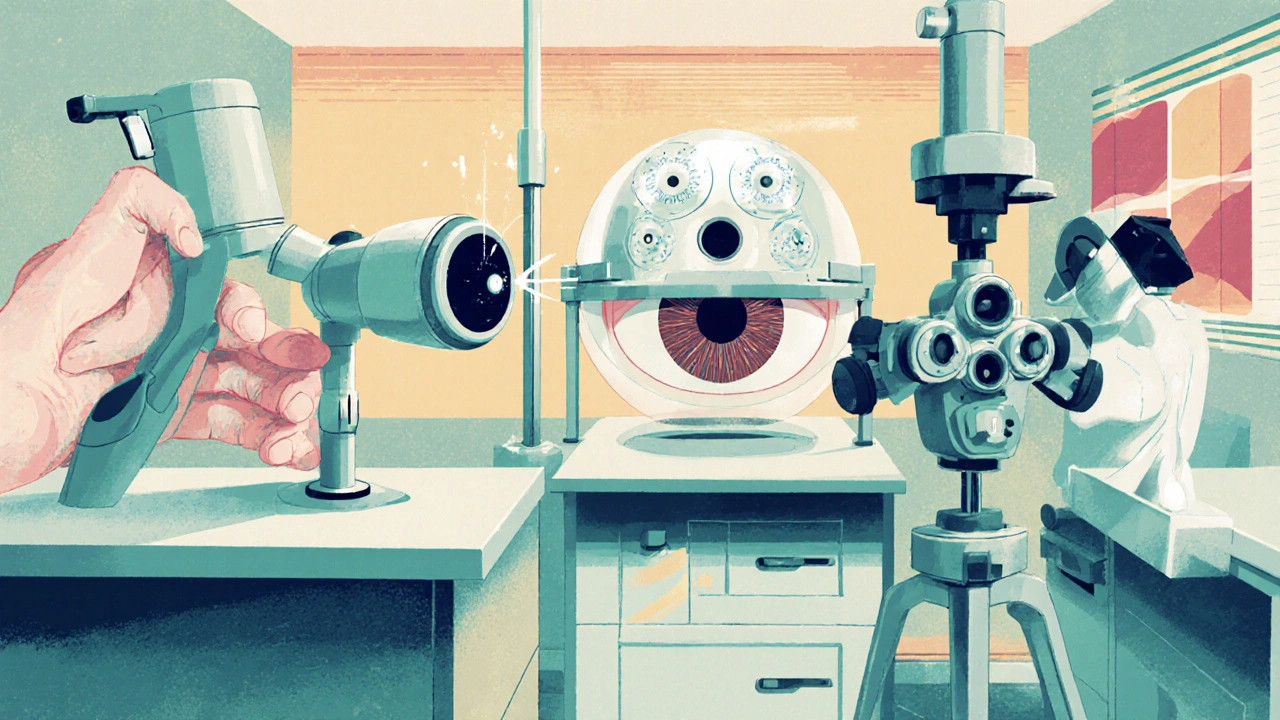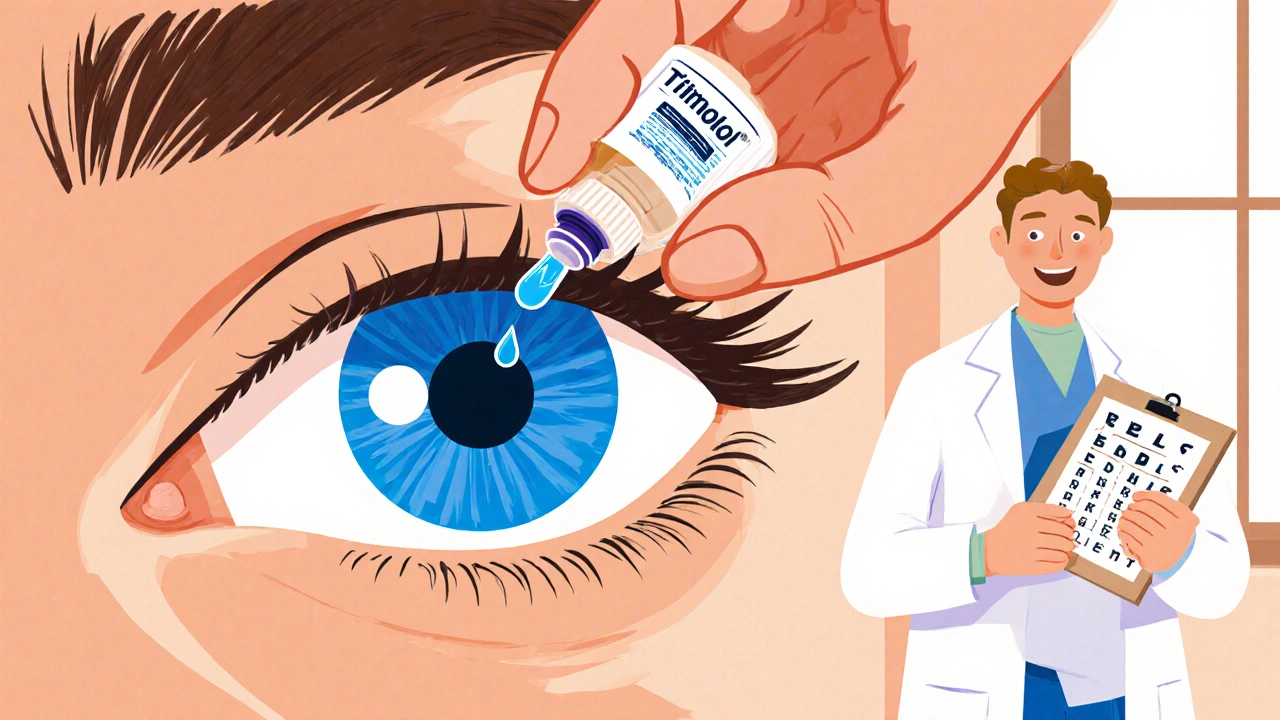Glaucoma Eye Exam Frequency Calculator
This calculator helps you determine your recommended eye exam frequency based on your glaucoma risk category and intraocular pressure (IOP) stability. The information is derived from medical guidelines for Timolol users.
Important: Always follow your ophthalmologist's specific recommendations.
Risk Category
IOP Stability
Recommended Exam Frequency
When you’re prescribed Timolol eye exam, it’s easy to think the medication does all the work. In reality, the drug is just one piece of a longer puzzle that keeps your vision safe. Regular eye exams act like a health‑check‑up for your eyes, catching problems before they turn into permanent damage.
What is Timolol and How Does It Work?
Timolol is a non‑selective beta‑blocker eye drop used primarily to lower intraocular pressure in glaucoma patients. Approved by the FDA in 1978, it reduces the eye’s production of aqueous humor, the fluid that maintains pressure inside the globe.
Lowering that pressure protects the optic nerve - the bundle of nerve fibers that carries visual information to the brain. When pressure stays high for too long, the optic nerve starts to thin, leading to irreversible vision loss.
Why Eye Exams Remain Essential
Even though Timolol can keep pressure in check, several factors can throw the balance off:
- Changes in medication adherence (missed doses, wrong technique)
- Development of tolerance or reduced drug efficacy over time
- Side effects that influence corneal health or tear production
- Progression of the underlying disease despite pressure control
Only a qualified ophthalmologist can spot these issues during a comprehensive exam.
What Happens During a Comprehensive Eye Exam?
A standard glaucoma visit includes several tests that together paint a full picture of eye health:
- Intraocular Pressure (IOP) Measurement: A tonometer gently contacts the cornea to gauge pressure, typically reported in mmHg.
- Optic Nerve Assessment: Using a fundus camera or direct ophthalmoscope, the doctor examines the optic disc for cupping or thinning.
- Visual Field Test (Perimetry): The patient looks at a central point while lights appear in peripheral locations. Missing lights indicate blind spots.
- Dilated Examination: Eye drops widen the pupil, allowing a view of the retina, macula, and peripheral retina.
- Corneal Thickness (Pachymetry): A pachymeter measures how thick the cornea is; thicker corneas can mask high pressure.
These components are the building blocks for deciding whether Timolol is still the right choice or if another drug or laser procedure is needed.

How Often Should You Schedule an Exam?
Frequency isn’t one‑size‑fits‑all. It hinges on risk level, disease stage, and how well Timolol is controlling pressure. Below is a quick guide:
| Risk Category | IOP Stability | Recommended Exam Interval |
|---|---|---|
| Low (early‑stage, stable IOP < 18 mmHg) | Consistently within target range for 12+ months | Every 12 months |
| Medium (moderate disease, IOP 18‑24 mmHg) | Fluctuations ≤ 2 mmHg over 6 months | Every 6 months |
| High (advanced glaucoma, IOP > 24 mmHg or rapid progression) | Unstable or trending upward | Every 3-4 months |
These intervals are guidelines; your ophthalmologist may adjust them based on personal health history, family history of glaucoma, and any new symptoms.
Spotting Timolol Side Effects Early
While Timolol is generally safe, it can cause ocular and systemic reactions. Regular exams help catch them when they’re still manageable.
- Dry Eyes: Reduced tear production can irritate the cornea and increase infection risk.
- Blurred Vision: Often temporary after dosing, but persistent blur may signal underlying issues.
- Reduced Pupil Size (Miosis): May affect night vision and increase glare sensitivity.
- Systemic Effects: Low blood pressure, slowed heart rate, or asthma exacerbation in susceptible individuals.
If you notice any of these symptoms, bring them up at your next appointment. The doctor may suggest lubricating drops, adjust the dosing schedule, or switch to a different class of medication.
When to Call Your Eye Care Provider Immediately
Some red‑flag signs demand prompt attention, regardless of the next scheduled exam:
- Sudden loss of peripheral vision or “tunnel vision.”
- Severe eye pain, especially if accompanied by nausea.
- Rapidly worsening blurry vision that doesn’t improve after a few minutes.
- Signs of an allergic reaction: itching, swelling, or rash around the eye.
These symptoms could indicate a spike in intraocular pressure, an infection, or an adverse drug reaction that needs immediate treatment.
Tips for Maximizing the Benefits of Timolol and Your Exams
- Stick to the Dosing Schedule: Use a reminder app or set alarms. Missing doses can let pressure creep upward.
- Follow Proper Drop Technique: Pull the lower eyelid down, place a single drop, and close the eye gently for 1-2 minutes. Avoid touching the tip to the eye.
- Track Your IOP at Home (if available): Some pharmacies rent portable tonometers. Recording numbers helps the doctor see trends.
- Maintain a Healthy Lifestyle: Regular exercise, a balanced diet rich in leafy greens, and controlling blood pressure all support eye health.
- Bring All Medications to the Exam: Other eye drops or oral meds can interact with Timolol.
These habits turn a quarterly check‑up into a proactive partnership with your eye doctor.
Frequently Asked Questions
Can I stop using Timolol if my pressure is stable?
Never stop or change dosage without consulting your ophthalmologist. Even stable pressure can hide underlying damage that only an exam can reveal.
Do I need a dilated exam every visit?
Most glaucoma follow‑ups include dilation at least once a year. It lets the doctor see the peripheral retina where early damage often appears.
What if I’m allergic to timolol?
Allergic reactions can cause redness, itching, and swelling. Switch to another class, such as prostaglandin analogs, after a thorough evaluation.
Is it safe to use Timolol with other eye drops?
Generally yes, but spacing matters. Wait at least 5 minutes between drops to avoid dilution and ensure each medication works properly.
How does Timolol differ from prostaglandin eye drops?
Timolol reduces fluid production, while prostaglandins increase outflow through the trabecular meshwork. Many patients use a combination if a single drug doesn’t achieve target pressure.


Devendra Tripathi
Honestly, the whole hype around quarterly eye exams feels like a cash‑grab for ophthalmology clinics. Timolol already does the heavy lifting, so why bother with extra monitoring? If you miss a dose, the pressure will spike anyway, making the exam pointless. The industry just wants you to sit in a chair and pay for tests you don’t need.